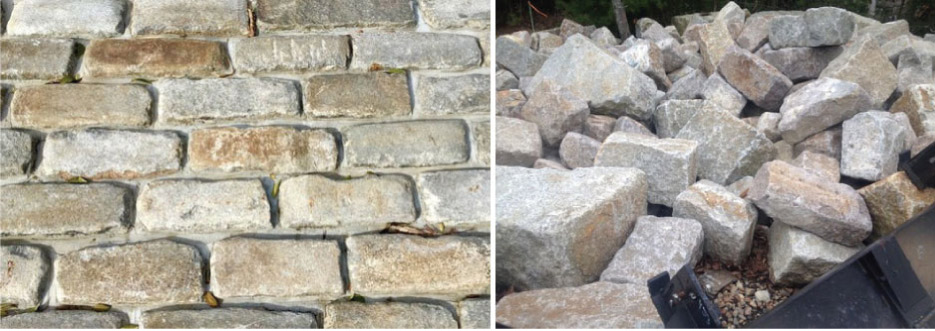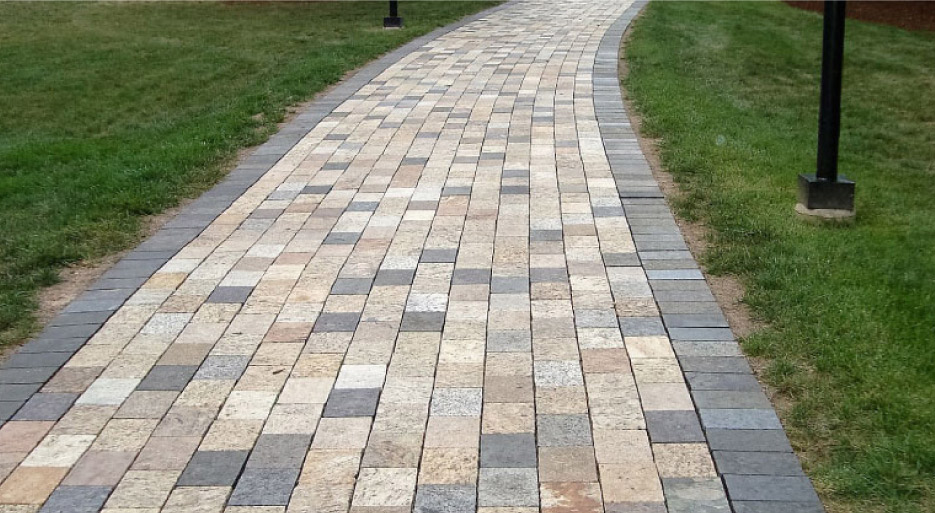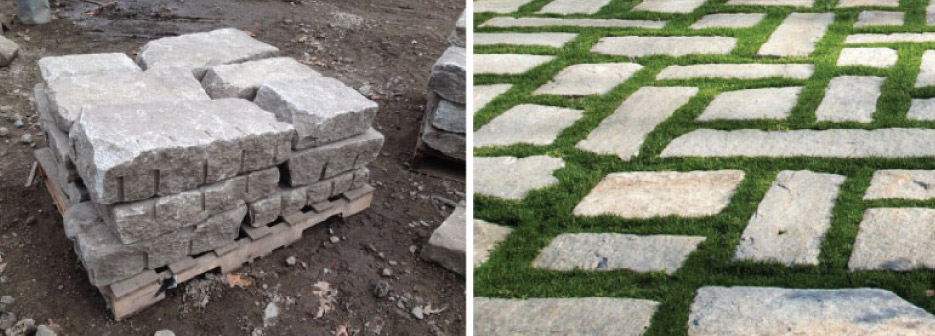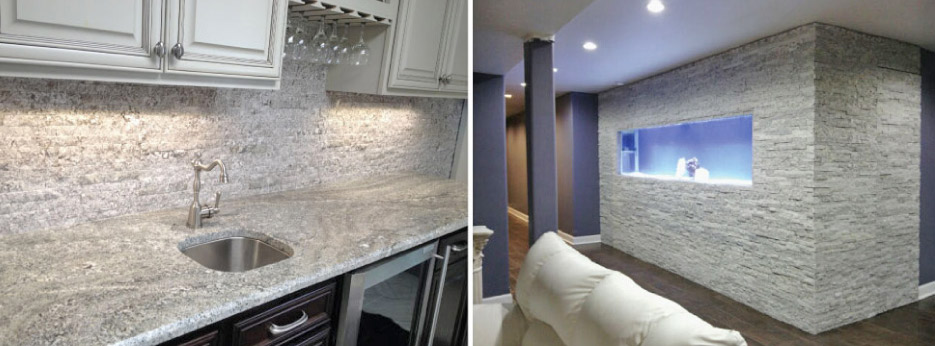Saving a Piece of History With Natural Stone
Using Recycled Stone for Green Building Projects
Stephanie Vierra
Assoc. AIA, LEED AP BD+C Vierra Design & Education Services, LLC
usenaturalstone.org
Have you ever wondered what happens to building materials after they are created, installed, and have served their useful life? Often, disposable products end up in landfills after they wear out. Today homeowners, designers, and architects are instead seeking materials that make a longer lasting impression on their projects and serve more than one useful life. There is a growing trend to reduce waste, conserve resources, and create more sustainable buildings and a sustainable way of life.
 |
|
These Big Dig cobblestones have a traditional patina that blends into many environments. Right: Semi-dimensional reclaimed granite blocks – raw material harvested and awaiting repurposing. Photos courtesy Stone Farm Living |
Natural stone can easily be reused, repurposed, and recycled into new applications and projects. From whole buildings to building elements such as flooring, walls, or countertops, and landscape components including pavers, blocks, steps, treads, landings, or decorative accents, stone offers a wide range of options for second life designs. Natural stone is only enhanced over time as the patina improves with age and its technical characteristics tend to remain unchanged. Stone speaks volumes about the quality of a project as it can perform and look beautiful for many lifetimes.
Natural stone ages well and retains its value. Whereas many building materials become unsightly over the course of many years, natural stone will transform with a natural patina. As an added benefit, it holds 93 percent of its original value at its peak, which is a higher percentile than most other cladding options.
Incorporating Natural Stone into Building Projects
Incorporating a recycled stone may take some extra time at the outset of a project and close coordination throughout design and construction. However, the rewards are worth it. Not only are you saving a valuable part of history, you are also letting the stone continue to tell its story and be a part of a new chapter in time, contributing to less materials ending up in landfills, and saving resources that would otherwise be used to create new materials. Using stone in the project may also qualify for credits in green building rating systems such as LEED and the Living Building Challenge (LBC). Consult a sustainability professional or architectural firm about entering into the LEED or LBC process to ensure you are using a stone that can be provided in the quantity, time frame, and budget, while also meeting the rating system’s requirements.
It is important to first define the project. What look, color, style, function, and application do you wish to achieve? Then get to know the local environment. Are there historic stone buildings or stone quarries in your area that have played a significant role in the design and architecture of the place that could provide a source of stone to reuse? Are there architectural salvage yards nearby to explore for materials waiting to be reused, repurposed, or renewed? Are there stone fabricators and installers with experience in repurposing stone? Do the stone yards and fabricators have scraps left over from their fabrication process available for use? Do you have a preference for antique French limestone or Italian marble? The search for these materials may add additional time and resources to the project if you cannot locate a source within the U.S. But the result is the same: a project that will last for many more years.
There are recycled stone sources around the country with inventory organized by type and source of stone and potential applications. Ask what types of stone are available for repurposing as you begin your search. Typical sources may come from curbing, cobblestones, granite blocks, pavers, posts, foundations, or quarry tailings from the fabrication process. In many cases the stone can simply be cleaned up and prepared for repurposing into a new application using the same methods as newly fabricated stone. But fabricating a new design element from old stones is also an option.
 |
|
Above: Recycled granite pavers find new life as a walkway. |
 |
|
Above, left: Palette of stone after harvesting and ready for re-installation.
|
Resources for Using Recycled Stone
The company Recycled Granite believes no stone should ever end up in a landfill. They recycle 2 million tons of stone waste every year and their business is growing, demonstrating that recycling stone contributes to job creation and waste diversion. Their inventory consists of stones originally quarried in Brazil, China, India and many other countries, most of which is granite, one of the oldest, most abundant and durable building materials. Then they partner with fabricators to help save them on disposal costs. They agree that recycled stone can be installed the same way any other tile or paver is installed. They have used thinset mortar for wall veneers or simply dry stack the stone; and pavers have been installed using polymeric sand, which effectively locks them in place. The key to success is knowing how to get the highest value out of the material you are working with and offer these tips:
- Choose a timeless color to guarantee lasting beauty and appeal.
- If you see something you like, get it while you can. There is a chance you won’t see it again since recycled stone choices may be limited.
In New England, where there is a rich history of stone quarrying and stone buildings, Stone Farm Living has harvested cobblestones from historic Faneuil Hall in Boston, paving stones from the Boston Common, and even cobbles from Belgian villages, all for new use elsewhere. The patina of stone is their passion as it is unique and can’t be imitated. They and their clients understand and appreciate that using natural elements makes good design even better. They recycle hundreds of 20-ton loads a year and generally get the material from contractors who come across it in their work.
 |
|
Left: Over 200 pounds of white antique granite were dry stacked in this backsplash and did not require any grout. The granite pieces are the cut-offs from the fabrication process which were split by people with special needs, creating jobs for people with disabilities; a program Recycled Granite calls Green Abilities.
|
Cobblestones, road curbing, granite foundation blocks and stone building parts are some of the bigger categories. Their advice to homeowners is: be prepared to handle variability in sizes, as the material was often handmade. They frequently see this with steps and landings. People want an old landing and come to them with very specific sizes. It is better to come with a range of sizes that may work as they are not making them a new landing. They want their clients to use their imagination because they can take old stone and cut it into new products that provide a new function while preserving the old look and patina. They have learned that there is a use for virtually every old stone—you just may not see it right away. So they like to talk to people about their vision and then help them find the right material.
Stephanie Vierra is a consultant specializing in curriculum development, project management, and research in sustainability and holistic design.